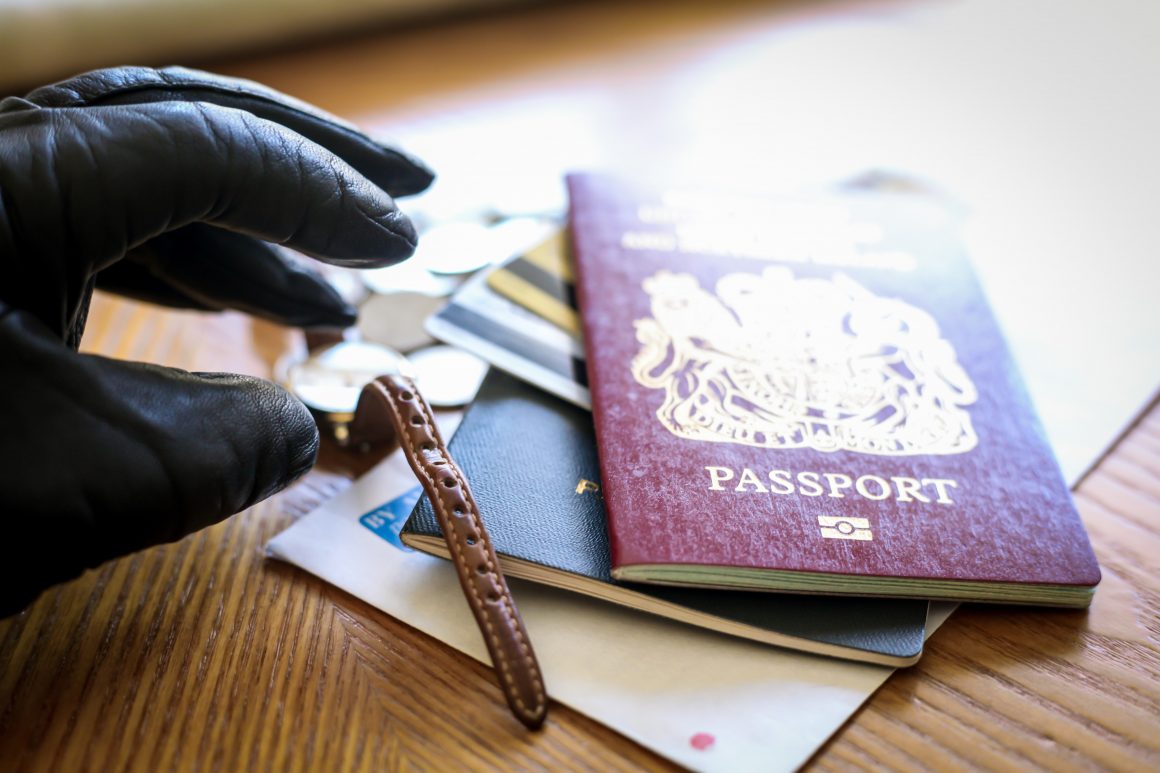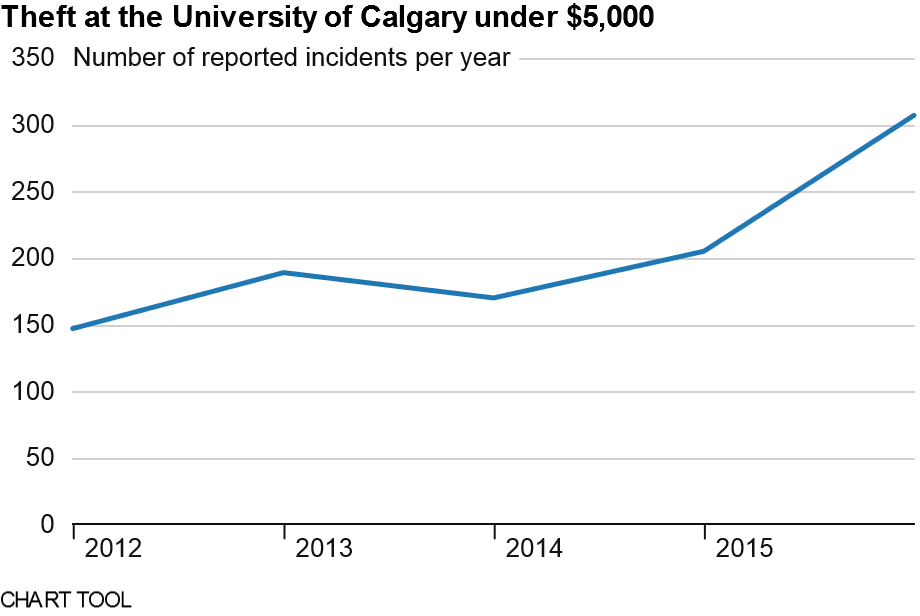
The rising problem of theft at the University of Calgary
By Scott Strasser, April 21 2017 —
There is no doubt that theft has been on the rise at the University of Calgary. Whether it’s from desperation due to Alberta’s economic downturn or a false sense of security among U of C students, thieves are striking more and more often on campus.
In mid-March 2017, campus security noticed a spike in the amount of break-and-enters reported at the U of C. In less than a month, they received eight reports of break-and-enter and six reports of attempted break-and-enter on campus. In comparison, there were just 12 reported incidents in 2016.
In almost every incident this year, the perpetrators were using a pry-bar to enter someone’s office in pursuit of cash.
“Most of these are related to people who are looking for cash or something that can be sold,” chief of campus security Brian Sembo said. “Some personal items are gone, [as well as] some university items.” 
Campus security sent out a community advisory email on April 10 to inform students of the increase. Sembo said Calgary Police Services has been contacted on every reported case of break-and-enter and the CPS are now assisting with the investigation.
But the increase in break-and-enters is just one of many recent headlines related to theft at the U of C. In campus security’s most recent annual report, released on Jan. 14, reported incidents of theft under $5,000 were up 50 per cent from the previous year — 307 reported incidents in 2016 compared to 205 in 2015. In comparison, 2012 saw just 147 reported incidents of theft under $5,000 at the U of C.
Vehicle theft and bicycle theft on campus also increased in 2016. Ten vehicles were reported stolen in 2016, compared to the eight reported stolen in 2015 and the six in 2014. Fifty-four bicycles were reported stolen in 2016, compared to 46 in 2015.
In March of 2016, campus security reported a noticeable spike in theft in two particular areas — the Taylor Family Digital Library and the changing rooms in the kinesiology complex. Items reported stolen included laptops, wallets, credit cards, handbags, cell phones and backpacks.
The kinesiology changing rooms were hit particularly hard that March. Sembo said there were 19 reported thefts from changing room lockers in the first three months of 2016, with 12 falling in the first three weeks of March.

Ten cars were reported stolen at the U of C last year // Photo by Mariah Wilson
“These are crimes of opportunity,” Sembo said at the time. “People are coming by, noticing the door’s open and taking whatever they can get their hands on.”
As a result, campus security officials sent out a community advisory email to inform students of the recent uptake in theft and urge them to protect their belongings. Campus security officers also increased their patrols and reviewed closed circuit television (CCTV) footage in high-risk areas to try and detect crime patterns. They also placed posters around campus — particularly in the TFDL — to remind students to keep their belongings secured.
The U of C also suffered a barrage of bicycle thefts around the same time. In the first four months of 2016, the U of C experienced a 100 per cent increase in bicycle theft compared to the same time period in 2015.
Campus security manager of community operations Rick Gysen said bicycle theft is a problem that campus security deals with every spring.
“It’s definitely an endemic problem,” he said. “It’s high exposure, so we’re going to see that theft, unfortunately.”

Campus security officials say bike theft is an “endemic problem” on campus // Photo by Jarrett Edmund
Campus security officer Kris Ward has tracked bicycle theft at the U of C since 2011. His statistics show that nearly 200 bicycles have been reported stolen on campus in the last six years. Ward noted that 2013 and 2015 were particularly theft-heavy, with 39 and 46 bikes reported stolen, respectively. 2016 was even worse, with 54 reported thefts.
By spring 2016, with theft in multiple categories on the rise, it was clear that campus security needed to do more to address this growing problem. Community advisory emails, increased patrols and posters to remind students to protect their belongings obviously weren’t enough of a deterrent for thieves. Campus security’s solution was a massive increase in the amount of CCTV cameras.
According to campus security, there are currently around 800 CCTV cameras at the U of C. That is a far cry from the just 82 cameras that were on campus in early 2015. The major increase came with the recent introduction of a new security operations centre.
Most of the cameras were set up in new buildings at the U of C — like the Taylor Institute for Teaching and Learning — and old buildings that did not have a lot of surveillance previously, like the kinesiology building.
Despite the drastic increase in CCTV, Sembo said the U of C still lags behind other institutions. He said similar-sized universities can have anywhere from 3,500 to 9,000 cameras.
Campus security believes that CCTV can be an effective crime deterrent.

CCTV presence has increased ten-fold at the U of C in the last two years // Photo by Scott Strasser
“Places like the bookstore, we’re certainly getting anecdotally good reports about the deterrence factor of having those additional cameras in those areas,” Sembo said. “Additionally, CCTV is already helping campus security and Calgary Police Services solve a number of complaints and crimes across main campus.”
Deterrence isn’t the only way CCTV can prove useful. The increased number of cameras was beneficial in late May 2016, when campus security identified two suspects of a large string of credit card thefts by reviewing CCTV footage. The two suspects were 22-year-old Calgarians Alexander Louis Harsanyi and Monica Rebalski.
For three months, the two had stolen debit and credit cards from Calgary’s three major post-secondary institutions — the U of C, Mount Royal University and the Southern Alberta Institute of Technology. With the help of Calgary Police Services, U of C campus security identified the two suspects.
Harsanyi and Rebalski had used one of the stolen credit cards at a vendor at the U of C. The owner of the stolen card saw on their credit card statement where and when the card had been used. By reviewing CCTV footage of that area at the right time, campus security was able to pinpoint the suspects.
“The capture of those folks for those thefts was directly attributed to that new CCTV system we installed,” Sembo said.
Harsanyi and Rebalski were eventually caught by a patrolling campus security officer at the U of C. The two were both charged with multiple counts of theft under $5,000 and fraud under $5,000.
Sembo said CCTV has helped in other cases as well.
“Not only have the trends [in crime] been upward but so have our captures,” he said. “I can’t tell you how many frauds and thefts we’ve solved, or at least identified the culprit as a result of CCTV. As that’s grown, so has our success in limiting theft.”

Campus security officials Rick Gysen (left) and Brian Sembo (right) // Photo by Scott Strasser
But CCTV can’t catch everything. Sembo said the recent break and enters that were reported occurred in buildings that do not have a high CCTV presence, including the Education Tower, Social Sciences, Math Sciences, Craigie Hall, Administration, Earth Sciences, Science A, ICT and TFDL. As a result, campus security has not yet pinpointed any suspects.
“They’re going to places where there’s no CCTV coverage, there’s nobody around after hours and they found their way into a building that’s been left insecure. That’s how they’re picking these buildings,” Sembo said. “To some extent, whoever is doing this has definitely made a point of checking out areas without CCTV.”
It’s hard to say how effective surveillance has really been. The 50 per cent increase in reported thefts under $5,000 in 2016 occurred despite the recent influx of CCTV on campus. It will be interesting to see if theft continues its upward trend at the U of C in the future. Campus security will release their first report of 2017 in May, outlining crime statistics for the winter 2017 semester.
If you’re a U of C student, staff or faculty member, remember that theft on campus is often preventable. Use common sense and keep an eye on your belongings. And if you don’t, hopefully your stuff was, at the very least, stolen somewhere with a couple of CCTV cameras nearby.
